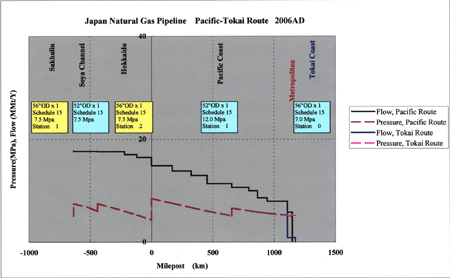Gas Flow Design Results: Phase 1 and 2
Trunkline specifications in Hokkaido was settled to utilize till Phase 2 stage, i.e., 1,422mmOD x 7.5MPa on-land piping of 30MMTPA capacity.
Trunkline specifications in Pacific Route was decided to utilize till final Phase 4 stage, taken into account difficulty of laying work under 200m sea bottom, i.e., 1,321mmOD x 12.0MPa offshore piping of 4,800t/hr capacity.
Specifications of the on-land trunkline in the vicinity of metropolitan area were set to apply the allowable pressure limit of 7.0MPa according to existing natural gas regulations, i.e., 1,422mmOD x 7.0MPa of 3,200t/hr capacity.
 Delivery Rates to Specified Regions are:
Delivery Rates to Specified Regions are:
- Hokkaido 300t/hr
Gas Transport in Pacific Route 1,700t/hr
- Tohoku 500t/hr - Kanto 400t/hr
- Tokyo 700t/hr - Tokai 100t/hr
Minimum installment of booster stations is enough to complete Phase 1 pipeline system, because of ample trunkline capacity to planned gas flow rate.
That is, only three stations are necessary at receiving Wakkanai, hub-station Tomakomai, and storage station Souma. In Pacific Route, maximum pressure can be reduced to 8.5MPa, 70% of 12MPa rated pressure.
 Delivery Rates to Specified Regions are:
Delivery Rates to Specified Regions are:
- Hokkaido 300t/hr
Gas Transport in Pacific Route 3,100t/hr
- Tohoku 700t/hr - Kanto 700t/hr
- Tokyo 1,400t/hr - Tokai 300t/hr
During Phase 2, initially specified 5 stations are necessary in Hokkaido due to 30MMTPA gas flow. In Pacific Route, however, the trunkline has still marginal capacity, and only additional 2 pumping stations are needed.
That is, Bihuka, Biei, and Semkappu stations shall be completed in Hokkaido trunkline. Only two stations at Kuji and Hitachi-naka in Pacific Route are required to accomplish the system.
to Gas Flow Design Phase 3
 Delivery Rates to Specified Regions are:
Delivery Rates to Specified Regions are: Delivery Rates to Specified Regions are:
Delivery Rates to Specified Regions are: